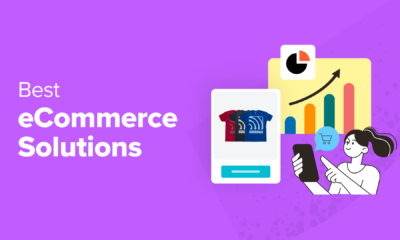MARKETING
Best 8 Ways To Increase Your Ad Conversion in eCommerce

A conversion on an eCommerce site is accounted for when a client makes a necessary move on your site. The required activity can normally be a deal, albeit this may be adding a thing to the truck or signing up for a pamphlet. Subsequently, your eCommerce conversion rate is the most common way of leading your possibilities towards your ideal results and tracking their development as they do as such.
Getting traffic to your site is challenging, particularly in a swarmed and cutthroat eCommerce field. When you effectively get guests to your online store, your site must be very much situated to change over whatever number of those imminent clients as could reasonably be expected! This implies your site should be engaging, adequately impart your worth, and give a consistent client experience from checkout through conveyance.
For that, you must take a look at the site here to hire best eCommerce developers
eCommerce stores can arrive at their conversion rate objectives by enhancing their site and administrative center tasks in the following ways:
I. Keep The Layout and Design Clean and Simple
A spotless and straightforward plan will help you grandstand your eCommerce store’s elements in a simple-to-find and engaging way. A decent client experience on your site will help your clients settle on purchasing choices rapidly. 80% of online customers quit shopping online because of confusing UI. You need your leads to have a smooth, consistent experience, guiding them towards what they’re looking for. To guarantee that, the pursuit bar on your site ought to be prominent.
Overall, 30% of web-based business webpage guests utilize the website’s pursuit usefulness. The guests who find what they’re looking for convert without any problem. The CTA buttons on your site should draw consideration without being annoying. Indeed, even the shade of a button for a CTA can influence its adequacy.
II. Know Your Demand Curve
Take a gander at Analytics, AdWords and Bing Ads in earlier years to see how your objective personas change in conduct consistently. Represent day-of-week and other occasional changes that might differ a seemingly endless amount of a large number of years.
To best anticipate when you’ll see request change straightaway, investigate factors, for example, the day an occasion falls on every year, occasional changes, and so forth. See how the bend changes with each component to best anticipate when you’ll see requests change this time around.
III. Select Long-Tail Keywords
Ideal keywords are high volume and low contest. It might require some investment and planning to find the best keywords, so lead some examination on what keywords your rivals are ranking for. Keep away from broad-tail keywords as these are significant level words that return a large number of results, so getting your page to rank will be extremely challenging.
Instead, utilize long-tail keywords to increase your shot at ranking on SERPs. Long-tail keywords very easily rank because of the lower search traffic and contest. In the thought/choice phases of the purchaser’s excursion . To more readily comprehend scan inquiries and well-known keywords for your site, allude to a portion of our cherished eCommerce SEO apparatuses for keyword exploration, and the sky is the limit from there.
IV. Use Extensions
Ad expansions assist buyers with learning more point-by-point information about your business on the SERP. Your telephone number, address, long periods of accessibility, links to landing pages and more are normal instances of augmentations. It’s essential to note that adding an augmentation doesn’t promise it will show within your ad. The expansion should offer meaningful worth, and your ad rank should satisfy a certain norm in a request for the web crawler to show your augmentations. In the screen capture underneath, perceive how we use links to our landing pages in our paid ads to assist searchers with finding precisely the thing they’re looking for and dive deeper into Groove as an organization.
V. Show Ads At The Right Time
The critical component of inbound marketing involves showing your ads to the perfect individuals at the ideal opportunity. Direct some exploration to determine when your crowd is the most dynamic on your advertising stages. Then, at that point, set the best ad plan for understanding your crowd. If you’re simply getting begun with paid inquiry, we prescribe setting your timetable to every minute of every day. After analyzing the reports and finding the most noteworthy crowd action time, slice your ad plan back to set aside cash.
VI. Fabricate A Negative Keyword List
Negative keywords will be keywords that you don’t need your site ranking for. By building this rundown, you tell web search tools not to show your ad for those keywords.
We suggest performing a Google search of your good keywords and identifying any keywords that appear corresponding to your positive keyword. Add them to your negative keyword list if they’re irrelevant to your image or don’t allure shoppers to change over.
VII. Target Mobile Devices
As we see an increase in versatile eCommerce patterns, make a point to use Google’s portable targeting capacities. If you have an ad that might provide food preferable to portable clients over work area clients, strategically make ads for versatile as it were. Presently like never before, customers utilize cell phones to shop. It’s important that your ads and, in the general site, are planned because of the portable client, so be certain that all coordinated landing pages follow versatile eCommerce best practices.
VIII. Adjust Geolocation Settings
Need to focus on a crowd of people in a specific area? Adjust your geolocation settings, so your ad shows just in that space. Google AdWords utilizes the buyer’s IP address or GPS area to determine whether the individual meets the rules and is shown your ad. We prescribe physical stores to adjust the geolocation settings for their ads for crowds in their space. It doesn’t damage to grow your crowd, however, begin with the important crowd that shops in the close-by region. Regarding eCommerce stores that sell exclusively online, grow your market potential by adjusting the geolocation settings to a bigger radius. No one can tell who might be interested in your items or administrations!
Wrapping up
To support conversion rate is to further develop your marketing profit from an investment. The more clients you convert, the higher is the effect you drive on your top line from your present traffic. The tips referenced above are extraordinary to begin to further develop your conversion rates strategically. Remember that a portion of these will probably drive preferable outcomes for your business over others. The significant thing is defining your objectives, gathering information, and continuously running objective tests to determine what resounds with your ideal interest group. If nothing works, you must contact a professional. For that, you must take a look at the site here to hire the best eCommerce developers.
Source link











You must be logged in to post a comment Login